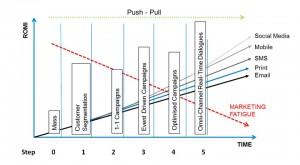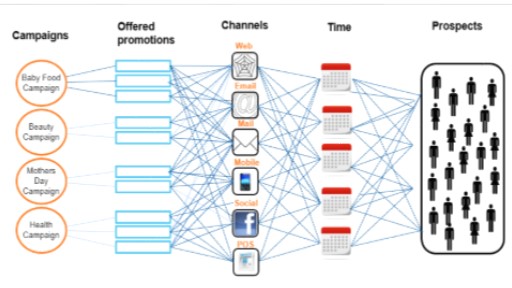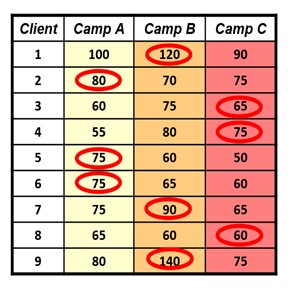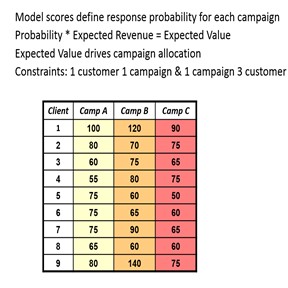
As a customer intelligence adviser, my work exposes me to a wide range of organisations with various marketing challenges and available resources. One of the common themes that have emerged is omni-channel marketing as a business imperative. Changes in the ways customers engage with brands across an explosion of channels have prompted the need for organisations to engage in omni-channel marketing.
Best practices are starting to emerge for mastering omni-channel marketing, and I've seen that they seem to fall into a five-step pattern, which I will lay out for you in this short blog series titled, Five steps to omni-channel marketing.
In the previous posts in this blog series, I’ve explained how you can evolve your marketing from customer segmentation to one-to-one marketing to event driven marketing, and now I’d like to elaborate on how to go on to optimised marketing.
The primary benefit of the previous step is that you become really relevant to your customers, engaging in pull marketing instead of push marketing. In that case, your marketing efforts are firmly based on the customer’s needs, as would be the case in a birthday campaign, or a market basket abandonment campaign, The downside of event-driven marketing is that customers can get over-contacted. I have clients that have more than 400 event driven marketing campaigns waiting to be triggered by customers In those situations, it’s easy to get over-contacted customers and fuzzy messaging since it’s not unusual for a customer to trigger multiple campaigns in short time frame. That outcome just takes you away from what should be your main objective: customer centricity. For that reason, it’s important to manage all of your campaigns and contact rules on a single platform to control the mass of event driven communications and avoid over-contacted customers.
From a commercial perspective it’s not interesting to send all the triggered communications to the customer. Every trigger has a communication cost and every contact needs to be relevant. To give you an example, the total cost of producing and sending a catalogue to a customer costs around 1 euro. If you have 1 million customers and you are sending out this catalogue 10 times a year this means that you have invested 10 million euros. So often our clients end up in a situation where they have many campaigns that can be sent through different channels at different time frames. One of the biggest challenges in that scenario is knowing which campaign should be stopped and which should be sent. The picture above shows the complexity of decisions an organization can face when planning their marketing campaigns.
The complexity of making the right decision for every customer increases even more when you want to take into account the corporate commercial strategy. The goal of most organizations is to make profits, so marketing departments just don’t get unlimited budgets, nor do they get unlimited email, call center, sales agent, or catalogue capacity. And any form of customer communications needs to demonstrate some impact, or a return on investment. Ideally, the return is maximised, which can be done by optimising the channel capacities at their respective lowest possible costs using the most relevant offers for every customer.
I have visited some banks that were obliged from a strategy point of view to send all their leads to sales agents, because the worst thing that could happen was that an agent go idle because they didn’t have any leads to handle. In many cases, a lot of leads sent by marketing ended up wasted because they didn’t have the capacity to fulfill all of them. The opportunity cost of those wasted leads should be as unacceptable as any possible idle sales agents.
Another possibility would be to focus on which people are in need and have the highest likelihood to respond to a sales call, crossed with the potential revenue profile of the customer, and then send those clients to the agents based on capacity to fulfill. Some customers might find a sales call intrusive, so another channel would be better for those kind of customers.
The complexity of today’s business environment has made traditional marketing approaches relics of a bygone era where “old fashioned” marketing looked more like broadcasting. Indiscriminately pushing out marketing campaigns now reliably deliver numerous adverse outcomes:
- Subjective, non-customer centric, planning/decision making,
- Ineffective use of channels,
- Poor long term customer value growth,
- Contact fatigue by over-soliciting customers,
- No ability to understand trade-off between key strategic decision elements,
- Hard to define best investment and engagement strategy.
Any one of those outcomes should be avoided. Across industries, I’ve seen the most effective approach is to apply marketing optimisation to select the best customers for every offer, taking into account your commercial strategy. Doing that helps you focus on two levels:
- Tactical: The best combination of customers, offers and channels, within a framework of policies and real-world business constraints, to maximise value for the organization.
- Strategic: Simulate alternative strategies (what-if analysis) to identify the optimal balance of resources and opportunities which will deliver the greatest return
To explain how optimisation finds the best combination of customers, offers and channels I have prepared a simple campaign example to the right.
In the above picture you see 9 customers who are eligible for 3 campaigns. The value of each campaign is determined by the propensity score multiplied by the expected revenue, which can be used to find a balance between your customer centric strategy and commercial strategy. The goal is to pick the best campaign for each customer, thereby maximising the expected revenue based on the following constraints:
- A customer can only receive 1 campaign
- Each campaign should have 3 customers.
Some people will find as a solution 675 or 705 depending on  which prioritisation method you use (by profile or by campaign). These results are found when you use prioritisation rules. But the maximum expected revenue we can generate from this set up is 780.
which prioritisation method you use (by profile or by campaign). These results are found when you use prioritisation rules. But the maximum expected revenue we can generate from this set up is 780.
You might be able to figure this out manually (as in this simple construct), but it quickly becomes too complex for most business environments, often with 100 or more campaigns, millions of customers and upwards of 40 business constraints. Optimisation will help you focus maximizing revenue and being relevant for every customer.
Strategic Focus:
The optimisation solution will also help you in strategic decision-making as you can immediately simulate the impact of your key decisions on the ROI. Even if given the chance, it’s rare to simply pick the optimal scenario, and typically there is a minimum number of offers per product. Another unlikely strategic scenario is to have any given channel be left unused – if they turn out to be ineffective, they are de-selected.
The optimisation approach allows you to compare different scenarios. Each scenario can have unique set of constraints (e.g. higher call center capacity, tighter budgets per campaign, minimum numbers of product offers) , which allows you to compare the results of each scenario as in the picture the below. You can see the objective value: which is what you are optimising. This can maximize profit, lower costs, etc., limit the number of offers, and the return on investment on your scenario.
 The ROI is not only given at an aggregate level but also calculated by campaign to give insights into which campaigns are bringing value and which are not, allowing you to decide which campaign offers should be increased or decreased. You see for example that we have limited profit from the current account cross-sell campaign in the picture to the right. From a strategic point of view you maybe want to increase this campaign as you have a minimum number of offers you need to make on this product.
The ROI is not only given at an aggregate level but also calculated by campaign to give insights into which campaigns are bringing value and which are not, allowing you to decide which campaign offers should be increased or decreased. You see for example that we have limited profit from the current account cross-sell campaign in the picture to the right. From a strategic point of view you maybe want to increase this campaign as you have a minimum number of offers you need to make on this product.
To be able to understand the impact of the strategic decisions the optimisation software gives an overview of the opportunity cost of each limitation you give to the current marketing set up. In this case we see that the maximum of 12,000 calls is giving us an opportunity of 2.08 and 4.84. The way it arrives at that opportunity cost is because the software calculates the effect of relaxing or tightening that constraint.
This is the way the optimisation step allows you to get more ROI out of your marketing investment. We have several customer cases where ROI get tremendously improved by taking this optimisation step and I urge you to check them out to learn more. The most detailed is a Forrester Consulting case study on Commerzbank called The Total Economic Impact of SAS Marketing Optimization. Other options to learn more about marketing optimisation include a customer success story about Akbank and these two whitepapers you can register to download:
- Improving multi-channel marketing with marketing optimization
- Real-Time Marketing Optimization Delivers Anytime Relevance for Financial Services
I hope you found this helpful. Check back for the next and final step in this process to omni-channel marketing. I'll comclude with how your marketing can be transformed into onmi-channel real-time dialogues. And as always - thank you for following!
Editor's Post-script:
My apologies to our readers - this post was originally published with a non-working link. Thanks for your patience!

